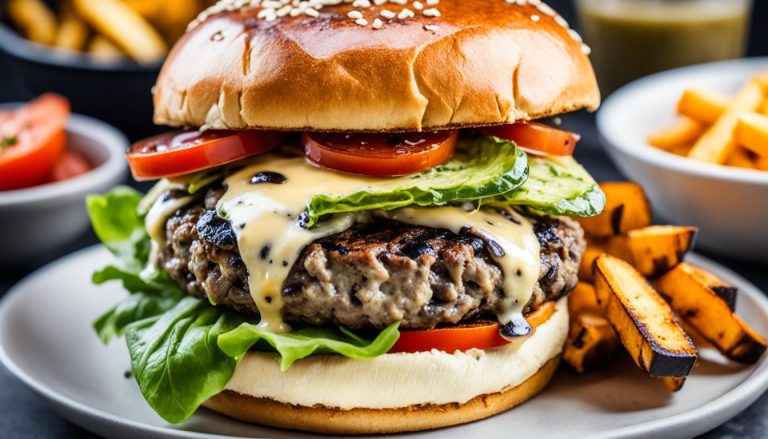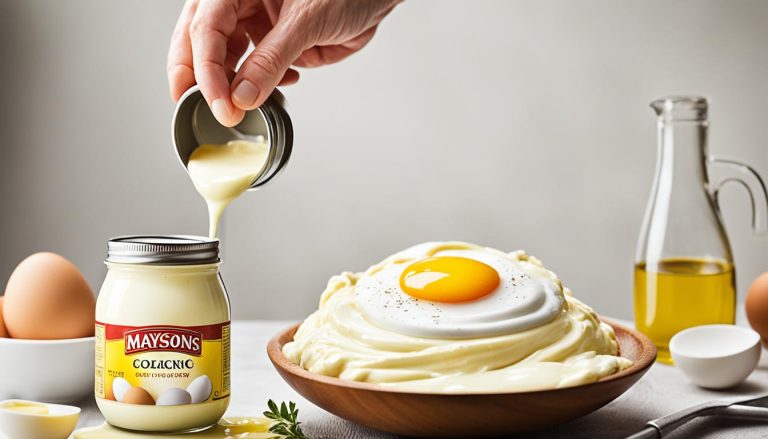The Victoria Sandwich is a cake that has stood the test of time. It’s a beloved treat, not only because of its simple yet delicious flavors, but also because it holds a special place in British culture.
This cake is perfect for those who are new to baking or those looking for a light and satisfying dessert. Here’s everything you need to know to make the perfect Victoria Sandwich.
What is a Victoria Sandwich Recipe?
The Victoria Sandwich, also known as the Victoria Sponge, is a traditional British cake that consists of two light and airy sponge cakes filled with jam and whipped cream.
Named after Queen Victoria, who was said to enjoy a slice with her afternoon tea, this delightful cake has become a staple in British baking. Its simplicity and elegant flavours make it a beloved dessert around the world, perfect for any occasion.
Ingredients for Victoria Sandwich Recipe
Below are the ingredients you’ll need to bake your own Victoria Sandwich:
| Ingredient | Amount |
| Self-raising flour | 200g (7 oz) |
| Caster sugar | 200g (7 oz) |
| Unsalted butter (softened) | 200g (7 oz) |
| Eggs (large) | 4 |
| Baking powder (optional) | 1 tsp |
| Milk | 2 tbsp |
| Vanilla extract | 1 tsp |
| Raspberry or strawberry jam | 100g (3.5 oz) |
| Double cream or whipped cream | 150ml (5 fl oz) |
| Icing sugar (for dusting) | To taste |
Victoria Sandwich Recipe Instructions
Preheat the Oven

- Set your oven to 180°C (350°F) or 160°C (320°F) for fan ovens. Grease and line two 20cm (8-inch) round cake tins.
Mix the Batter

- In a large bowl, cream together the softened butter and caster sugar until light and fluffy. Add the eggs one at a time, beating well after each addition. Stir in the vanilla extract.
Add the Flour

- Sift in the self-raising flour and baking powder, then fold gently until fully incorporated. Add the milk and mix until smooth.
Bake the Cakes

- Divide the mixture evenly between the two prepared cake tins. Smooth the tops and bake in the oven for 20-25 minutes or until golden brown and a skewer inserted into the centre comes out clean.
Cool the Cakes

- Allow the cakes to cool in the tins for 10 minutes before transferring them to a wire rack to cool completely.
Assemble the Cake

- Once the cakes are cool, spread the jam evenly on one of the cakes. Whip the double cream until soft peaks form and spread it over the jam. Top with the second sponge cake.
Finish and Serve
- Dust the top of the cake with a light sprinkling of icing sugar, slice, and serve.
Nutritional Information of this recipe
Here’s the nutritional breakdown of a standard serving (based on 8 servings):
| Nutrient | Per Serving |
| Calories | 320 kcal |
| Protein | 3g |
| Fat | 18g |
| Carbohydrates | 38g |
| Sugars | 25g |
| Fibre | 1g |
Note: The nutritional values may vary based on the specific ingredients used.
Serving Suggestions for Victoria Sandwich

The Victoria Sandwich is a versatile cake that can be enjoyed in various settings, making it an ideal choice for different occasions. Here are some creative and traditional ways to serve it:
Classic Afternoon Tea
- The Victoria Sandwich is a staple of the British tradition of afternoon tea. Serve it alongside a selection of finger sandwiches, scones with clotted cream and jam, and a variety of loose-leaf teas, such as Earl Grey or Darjeeling.
- The light texture of the cake pairs perfectly with the refreshing aroma of tea, creating a quintessentially British experience.
With Fresh Fruit
- Add a burst of freshness to your cake by serving it with seasonal fruits like strawberries, raspberries, or blueberries. You can either place the fruit on the side of each slice or top the cake with fresh berries for an extra layer of flavor.
- The tartness of the fruit complements the sweet jam and cream, creating a balanced taste.
With Ice Cream
- For an indulgent twist, serve the Victoria Sandwich with a scoop of vanilla ice cream or a fruit-flavored sorbet.
- The creamy ice cream contrasts beautifully with the light, fluffy sponge, and it adds a cool, refreshing element, especially during warmer months.
As a Birthday Cake
- The Victoria Sandwich can easily be transformed into a stunning birthday cake. You can decorate it with fresh flowers, colorful sprinkles, or edible glitter to give it a more festive appearance.
- For a personal touch, you could even add a birthday message written in icing on top.
With Whipped Cream and Chocolate Sauce
- If you’re in the mood for something extra decadent, serve the Victoria Sandwich with a dollop of whipped cream and a drizzle of rich chocolate sauce.
- The creaminess of the whipped cream and the richness of the chocolate sauce elevate the cake, making it a perfect dessert for celebrations.
A Light Dessert After a Hearty Meal
- Due to its light and airy texture, the Victoria Sandwich makes for a perfect dessert following a savory meal.
- Its sweetness won’t overpower the main course, and it provides a satisfying yet not overly heavy ending to your meal.
As a Picnic Treat
- Because of its simple, portable structure, the Victoria Sandwich is an excellent addition to any picnic. Cut into individual slices and wrap them in parchment paper for easy handling.
- It’s a great way to bring a taste of home to outdoor gatherings with friends or family.
With a Cup of Coffee
- For those who prefer coffee over tea, the Victoria Sandwich pairs wonderfully with a cup of espresso, cappuccino, or a latte.
- The rich, slightly bitter flavor of the coffee complements the sweet and fluffy cake, creating an enjoyable combination.
Common Mistakes to Avoid
Baking the perfect Victoria Sandwich can sometimes be tricky for beginners. Here are a few common mistakes to watch out for:
- Overmixing the Batter: This can lead to a dense, heavy sponge. Mix until just combined to keep the texture light and fluffy.
- Incorrect Oven Temperature: Make sure your oven is fully preheated to ensure even baking.
- Under or Over Baking: Always check the centre of the cakes with a skewer to ensure they’re cooked through. Overbaking can dry them out, while underbaking will make them soggy.
Victoria Sandwich Variations
Mary Berry Recipe for Victoria Sponge Cake Variation: Lemon Zest Twist
Difference: Adding lemon zest to the sponge batter gives a refreshing citrus flavor, making the cake lighter and more aromatic.
Instructions:
- Preparation: Follow Mary Berry’s recipe, creaming the butter and sugar together until light and fluffy.
- Lemon Addition: Add the zest of 1 lemon along with the eggs as you mix in the wet ingredients.
- Baking: Continue as per the original recipe, pouring the mixture into two greased and lined 8-inch round tins. Bake at 180°C for 20-25 minutes until golden and springy to the touch.
- Final Step: Once baked, allow the cakes to cool before filling them with jam and whipped cream, as per Mary Berry’s instructions.
- Result: The lemon zest brightens the flavour, giving the cake a subtle citrusy edge that complements the sweetness of the jam.
Gluten-Free Victoria Sponge Recipe Variation: Almond Flour Base
Difference: Replacing regular flour with almond flour creates a gluten-free sponge with a slightly nutty flavour and a denser texture.
Instructions:
- Preparation: Use a gluten-free self-raising flour blend (or almond flour for a more pronounced flavour) instead of regular flour.
- Baking: Follow the rest of the recipe, but bake for a little longer (about 30-35 minutes) as almond flour can make the sponge denser. Test with a skewer to ensure the cake is fully baked.
- Result: The almond flour makes the cake moist and rich with a delicate nutty flavour, perfect for gluten-free eaters.
Victoria Sponge Buttercream Recipe Variation: Strawberry Buttercream

Difference: Swapping regular buttercream for strawberry buttercream adds a fruity, tangy sweetness that complements the jam filling.
Instructions:
- Preparation: Follow the standard buttercream recipe, but add 2-3 tablespoons of fresh strawberry puree (strained to remove seeds) along with the powdered sugar and butter.
- Baking: Use this strawberry buttercream to sandwich the sponge layers, along with a layer of jam, as per the traditional method.
- Result: The strawberry buttercream offers a vibrant twist, adding a fresh, fruity burst to the classic cake.
Vegan Victoria Sponge Recipe Variation: Aquafaba Meringue
Difference: Using aquafaba (the liquid from canned chickpeas) as a substitute for eggs helps create a light, fluffy texture in a completely vegan version.
Instructions:
- Preparation: Substitute eggs with 3 tablespoons of aquafaba (the liquid from canned chickpeas). Whisk the aquafaba until soft peaks form, then fold it into the cake batter.
- Baking: Bake the sponge in the same way as the traditional recipe, adjusting the baking time to 25-30 minutes for a fluffy, light texture.
- Result: The aquafaba helps to replicate the airy quality of a traditional Victoria sponge, making it vegan-friendly but still deliciously soft.
Mini Victoria Sponge Recipe Variation: Individual Serve
Difference: Reducing the size of the cake into individual mini sponges makes it perfect for parties and afternoon teas.
Instructions:
- Preparation: Use mini cake tins (or a cupcake tray) and divide the batter between each compartment. The baking time will be reduced to about 12-15 minutes.
- Baking: Once baked, allow the mini cakes to cool completely.
- Assembly: Slice each mini sponge in half, fill it with jam and cream or buttercream, then sandwich them together.
- Result: These mini Victoria sponges are easy to serve at parties or as individual treats.
Recipe for Victoria Sponge Cake with Plain Flour Variation: Baking Powder Addition
Difference: If using plain flour instead of self-raising flour, add baking powder to ensure the sponge rises and is light.
Instructions:
- Preparation: Use 200g of plain flour and add 2 teaspoons of baking powder to the dry ingredients before mixing with the wet ingredients.
- Baking: Follow the rest of the recipe and bake at 180°C for 20-25 minutes or until golden brown and springy.
- Result: The baking powder ensures that the cake rises properly and achieves a light texture, even without self-raising flour.
Bero Victoria Sponge Recipe Variation: Milk Addition
Difference: Adding a small amount of milk (around 2 tablespoons) to the batter helps to create a slightly softer texture and lighter sponge.
Instructions:
- Preparation: Follow the Bero recipe but add 2 tablespoons of milk to the creamed butter and sugar mixture before adding the eggs.
- Baking: Bake according to the original instructions, checking the cake after 20-25 minutes.
- Result: The addition of milk makes the sponge softer, ensuring a fluffier texture.
Chocolate Victoria Sponge Recipe Variation: Cocoa Powder
Difference: Adding cocoa powder turns the sponge into a chocolate version, ideal for chocolate lovers.
Instructions:
- Preparation: Add 50g of cocoa powder to the flour before mixing with the other dry ingredients. Reduce the amount of sugar slightly (about 25g less) to balance out the richness of the cocoa.
- Baking: Bake as per the original recipe, adjusting the time to ensure the sponge is fully cooked through.
- Result: The chocolate adds depth and richness, transforming the classic Victoria sponge into a decadent treat.
James Martin Recipe for Victoria Sponge Variation: Buttermilk Sponge
Difference: Replacing regular milk with buttermilk gives the sponge a tender crumb and a slight tang, elevating the texture and flavor.
Instructions:
- Preparation: In place of regular milk, use 150ml of buttermilk. Mix it into the creamed butter and sugar mixture along with the eggs.
- Baking: Bake as per James Martin’s standard instructions, checking for doneness at 20-25 minutes.
- Result: The buttermilk gives the cake a soft, fluffy texture with a subtle tang that enhances the flavor of the jam and cream filling.
Conclusion
Victoria Sponge is a timeless classic, and with a few creative tweaks, it can be adapted to suit a variety of dietary preferences and flavor profiles.
Whether you’re looking for a lighter, fruit-infused version or a rich, decadent twist, there’s a Victoria sponge variation for everyone.
From gluten-free and vegan options to unique flavors like lemon, strawberry buttercream, or chocolate, these variations show how easy it is to personalize this beloved cake while keeping the essence of its airy texture and creamy filling.
FAQs
Can I make a Victoria sponge without eggs?
Yes, you can use alternatives like aquafaba (chickpea water) to replace eggs in a vegan Victoria sponge.
How do I make a Victoria sponge without self-raising flour?
Use plain flour and add baking powder (2 teaspoons per 200g of plain flour) to help the sponge rise.
What can I use instead of butter for a dairy-free Victoria sponge?
You can use dairy-free margarine or vegetable oil as a substitute for butter in the sponge.
Can I freeze a Victoria sponge?
Yes, you can freeze the sponge layers without filling, wrapped tightly in plastic wrap, and thaw before assembling.
How can I make my Victoria sponge more moist?
Adding a small amount of milk, buttermilk, or a fruity filling like fresh jam can help keep the sponge moist.

Victoria Sandwich Recipe
Ingredients
- 200 g Self-raising flour
- 200 g Caster sugar
- 200 g Unsalted butter
- 4 Eggs
- 1 tbsp Baking powder
- 2 tbsp Milk
- 1 tbsp Vanilla extract
- 100 g Raspberry or strawberry jam
- 150 ml Double cream or whipped cream
- Icing sugar
Instructions
- Set your oven to 180°C (350°F) or 160°C (320°F) for fan ovens. Grease and line two 20cm (8-inch) round cake tins.
- In a large bowl, cream together the softened butter and caster sugar until light and fluffy. Add the eggs one at a time, beating well after each addition. Stir in the vanilla extract.
- Sift in the self-raising flour and baking powder, then fold gently until fully incorporated. Add the milk and mix until smooth.
- Divide the mixture evenly between the two prepared cake tins. Smooth the tops and bake in the oven for 20-25 minutes or until golden brown and a skewer inserted into the centre comes out clean.
- Allow the cakes to cool in the tins for 10 minutes before transferring them to a wire rack to cool completely.
- Once the cakes are cool, spread the jam evenly on one of the cakes. Whip the double cream until soft peaks form and spread it over the jam. Top with the second sponge cake.
- Dust the top of the cake with a light sprinkling of icing sugar, slice, and serve.









